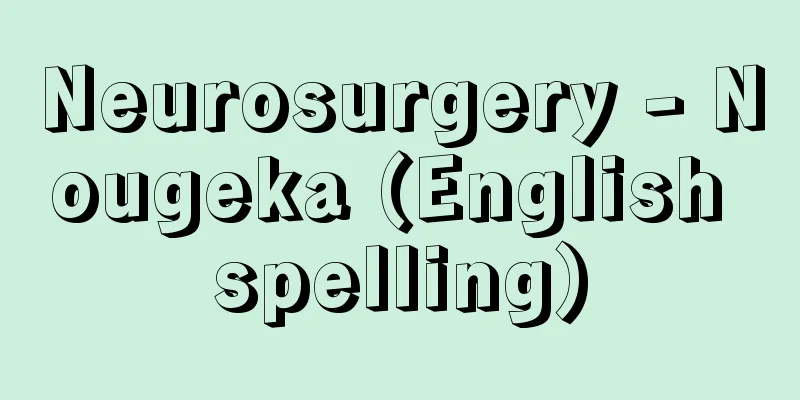Neurosurgery - Nougeka (English spelling)

|
This is a medical specialty that deals with surgical diseases of all nervous systems, including the brain and spinal cord, peripheral nerves, and autonomic nerves (congenital malformations, tumors, vascular disorders, inflammation, trauma, functional diseases, etc.); it is also known as neurosurgery, and its official name is neurosurgery. In Japan, due to the unique development of the medical community, some spinal cord diseases are also treated by orthopedic surgery, and peripheral nerve diseases are often treated by orthopedic surgery or plastic surgery. Therefore, the main diseases treated by neurosurgery are those of the central nervous system, and among them, the overwhelming majority are diseases of the brain. Historically, there is evidence that brain surgery was performed in ancient Egypt and Greece. However, this ancient brain surgery was limited to epidural manipulation and was not based on scientific evidence as is the case today. It is believed to have been a form of magic aimed at treating epilepsy and mental disorders. Modern brain surgery began in 1879 when William Macewen (1848-1929) removed a brain tumor thought to be a meningioma (the patient survived for eight years after the operation), which is thought to be the first recorded case of brain tumor surgery in the world. In 1884, Rickman Godlee (1849-1925) of England successfully removed a brain tumor using aseptic techniques. Macewen and Victor Horseley (1857-1916) of England also successfully removed spinal tumors. In Germany, Fedor Krause (1856-1937) was a famous surgeon who performed an operation to relieve pain from trigeminal neuralgia in 1892 and an operation to remove a pineal tumor in 1913. Thus, neurosurgery originated and developed in Europe at the end of the 19th century. However, it was not until the 20th century that the modern system of neurosurgery was established. That is to say, neurosurgery, which was born in Europe, was spectacularly developed in the United States by Harvey W. Cushing (1869-1939), who became a professor at Harvard University in 1912. Cushing operated on about 2,000 cases of brain tumors in his lifetime, and kept detailed records of all of them with drawings. Cushing's achievements were enormous, and he introduced the electric scalpel, invented tools such as clips, and developed many surgical techniques. His notable achievements include the discovery of Cushing's phenomenon, research into the pathology and treatment of pituitary adenomas, the discovery of ACTH-producing adenomas known as Cushing's disease, and research into the pathology of acromegaly. Furthermore, he laid the foundation for today's histological classification of brain tumors, introduced radiation therapy for malignant brain tumors, and many more. He is called the father of neurosurgery, and the American Neurological Association is named the Cushing Society in honor of his achievements. The invention of pneumocephalus by Walter E. Dandy (1886-1946) of the United States and cerebral angiography by Moniz of Portugal promoted rapid advances in diagnostic methods, and at this point the prototype of today's neurosurgery was completed. After that, advances in anesthesia, infusions and blood transfusions, the introduction of antibiotics to prevent infection, and measures against cerebral edema using steroid hormones were implemented, improving the safety of neurosurgery, leading to a dramatic increase in its popularity since 1950. Then, in the mid-1960s, the introduction of the surgical microscope made it possible to perform surgeries that had previously been impossible, and the development of CT (Computed Tomography) in 1971 brought about immeasurable advances in diagnosis. On the other hand, in 1947, E. A. Spiegel and H. J. Wycis performed stereotactic brain surgery through a very small burr hole to treat involuntary movements and stubborn pain. Brain vascular anastomosis with a diameter of less than 1 mm was also established, and the introduction of laser beams and other techniques is making previously difficult surgeries safer. In the 1980s, MRI (Magnetic Resonance Imaging) was developed, making brain imaging diagnosis clearer and more accurate. Since then, images have become even clearer, and at the same time, three-dimensional images and MRA (Magnetic Resonance Angiography), a method of angiography using MRI, have been developed. Since the 1970s, the superconductive quantum interference device (SQUID) was developed to measure brain magnetic fields, and magnetoencephalography (EMG) was developed to examine the source of currents in the brain and induced magnetic fields. Along with these advances in examination and surgery, radiation therapy has also played a major role. The most common radiation therapy for brain tumors is irradiation with ultra-high voltage X-rays (Linac (linear accelerator)), but brachy therapy, an intratumoral irradiation method in which isotopes are locally injected, has also been used. Since the 1950s, cyclotron and fast neutron beam irradiation methods and boron neutron capture therapy using nuclear reactors have also been used. Recently, heavy particle beam therapy, which uses a synchrotron to irradiate carbon or neon atomic nuclei, has also been applied clinically, and in Japan, treatment for brain tumors began in 1994. Regarding localized radiation therapy of the brain, Lars Leksell of Sweden invented a device that can concentrate gamma rays with a fine diameter and developed the gamma unit (commonly known as the gamma knife). This method allows high doses of gamma rays to be concentrated on a local area of the brain while minimizing the amount of radiation exposure to the surrounding normal brain, making it possible to treat not only brain tumors but also cerebral arteriovenous malformations without opening the skull. On the other hand, intratumoral irradiation, which involves injecting isotopes into the tumor, is fraught with difficulties in protecting against radiation exposure, so a photoelectron stereotactic radiotherapy device called the PRS (photoelectron radiosurgical system) was developed that can electrically irradiate X-rays from the tip of a needle. It is expected that this method will also be widely used in the future as an intraoperative irradiation method for tumors left behind by surgery. In this way, we can see that neurosurgery is constantly advancing toward less invasive, safer, and more reliable diagnosis and treatment methods by constantly incorporating new science and engineering technologies. [Mizuo Kagawa] [Reference] | |Source: Shogakukan Encyclopedia Nipponica About Encyclopedia Nipponica Information | Legend |
|
脳・脊髄(せきずい)をはじめ、末梢(まっしょう)神経や自律神経を含むすべての神経系の外科的疾患(先天性の形態異常、腫瘍(しゅよう)、血管障害、炎症、外傷、機能的疾患など)を扱う診療科目で、神経外科ともいい、正式には脳神経外科という。 日本では医学界の独自の発展過程から、脊髄疾患の一部は整形外科でも扱われ、末梢神経の疾患も整形外科や形成外科で扱われることが多い。したがって、脳神経外科の対象となる疾患で中心となるのは中枢神経系であり、なかでも脳の疾患が圧倒的に多い。 歴史的にみると、古代エジプトやギリシア時代にも脳手術が行われていた形跡がある。しかし、この古代史的脳手術は硬膜外の操作にとどまり、かつ今日のような科学的根拠に立脚したものではなく、てんかんや精神障害を対象とした、多分に呪術(じゅじゅつ)的色彩の濃いものであったと考えられている。近代的な脳外科の発生は、1879年にマイスウェンWillam Macewen(1848―1929)が髄膜腫と思われる脳腫瘍を摘出したが(患者は術後8年間生存)、この手術が記録にとどめられた脳腫瘍の世界最初の手術例と思われる。また、84年イギリスのゴッドレーRickman Godlee(1849―1925)が、無菌法を用いて脳腫瘍の摘出に成功した。脊髄腫瘍に対しては、イギリスのマイスウェンやホースレイVictor Horseley(1857―1916)が摘出に成功している。ドイツではクラウゼFedor Krause(1856―1937)が著明な外科医で、1892年に三叉(さんさ)神経痛に対する除痛手術、1913年には松果体腫瘍の摘出術を行っている。このように脳神経外科は19世紀末にヨーロッパで発祥し発展した。しかし、現代のような脳神経外科学の体系が築かれたのは、20世紀になってからのことである。すなわち、ヨーロッパで誕生した脳神経外科は、1912年にハーバード大学教授に就任したクッシングHarvey W. Cushing(1869―1939)によって、アメリカで華々しく発展した。クッシングは生涯に約2000例の脳腫瘍を手術し、そのすべてに詳細な絵をつけて記録を残している。クッシングによる業績は膨大なもので、電気メスを導入したり、クリップなどの道具をくふうし、かつ多くの手術法を開発した。クッシング現象の発見、下垂体腺腫(せんしゅ)の病態と治療に関する研究、クッシング病とよばれているACTH産生腺腫の発見や末端肥大症の病態に関する研究などは特筆すべき業績である。さらに脳腫瘍の今日の組織学的分類の基礎を築き、悪性脳腫瘍に対する放射線治療を導入するなど数えればきりがない。脳神経外科の父と称され、アメリカ脳神経学会はその業績を称えてクッシングソサエティーCushing Societyとよばれている。そして、アメリカのダンディWalter E. Dandy(1886―1946)の気脳撮影やポルトガルのモーニスの脳血管撮影の創始は、診断法の急速な進歩を促し、この時点で今日の脳神経外科学の原型が完成された。その後、麻酔法や輸液・輸血の進歩、抗生物質の導入による感染対策、ステロイドホルモンなどによる脳浮腫対策が講じられ、脳神経外科手術の安全性が高められて、1950年以降、飛躍的に普及するに至った。そして1960年代なかばから、手術用顕微鏡が導入されて、従来不可能とされていた手術が可能となり、さらに1971年になって開発されたCT(コンピュータ断層撮影法)は、診断面において計り知れない進歩をもたらした。また一方では、1947年にスピーゲルE.A.SpiegelとワイシスH.J.Wycisは、きわめて小さい穿頭孔(せんとうこう)から行う定位的脳手術により、不随意運動や頑固な痛みに対する治療を行った。直径1ミリメートル以下の脳の血管吻合(ふんごう)術も確立され、またレーザー光線などの導入により、従来多くの困難を伴った手術をより安全にできるようになりつつある。1980年代にはMRI(磁気共鳴映像法)が開発され、脳の画像診断はいっそう明瞭(めいりょう)正確になってきた。その後今日に至るまで、画像はさらに鮮明になり、同時に三次元画像の描出や、MRIを用いた血管撮影法MRA(magnetic resonance angiography)が開発されてきた。1970年代からは脳磁場を測定するSQUID(superconductive quantum interference device)が開発され、脳内電流の発生源や誘発磁場の検査である脳磁図EMG(magnetoencephalography)が開発された。これら、検査法、手術法の進歩とともに放射線治療も大きな役割を担っている。脳腫瘍の放射線治療には超高圧X線Linac(linear accelerator)による照射がもっとも一般的に行われているが、アイソトープを局所注入する腫瘍内照射法brachy therapyも行われてきた。1950年代からはサイクロトロン、速中性子線照射法や原子炉を用いたホウ素中性子捕捉療法なども行われた。最近では、シンクロトロンを用い、炭素やネオン原子核を照射する重粒子線治療も臨床に応用されるようになり、わが国では、1994年(平成6)から脳腫瘍に対する治療が始っている。 脳の局所放射線治療に関してはスウェーデンのレクセルLars Leksellが微細な直径のガンマ線を集中させる装置を考案して、ガンマユニット(ガンマナイフと俗称される)を開発した。この方法によると脳の局所に高線量のガンマ線を集中照射できて、しかも周辺の正常脳に対する被爆量を最小限にとどめることができるので、脳腫瘍のみならず、脳動静脈奇形も開頭することなしに治療が可能になった。 一方腫瘍内にアイソトープを注入する腫瘍内照射法は放射線被爆防御のための困難さがつきまとうので、針の先から電気的にX線を照射できるフォトエレクトロン定位的放射線治療装置PRS(photoelectron radiosurgical system)が開発された。この方法は、手術で取り残された腫瘍の術中照射法としても今後広く活用されるようになると期待されている。このように脳神経外科は、理工学系の新技術を絶えず取り入れながら、低侵襲な、より安全、確実な診断、治療法へ向けて進歩し続けていることがわかる。 [加川瑞夫] [参照項目] | |出典 小学館 日本大百科全書(ニッポニカ)日本大百科全書(ニッポニカ)について 情報 | 凡例 |
<<: Agricultural Rites - Noukougirei
>>: Agricultural chemistry - Nougeikagaku
Recommend
Scarlet loberia
...It grows well in sunny, humid places, and in p...
Csokonai VM (English notation) CsokonaiVM
… [Osamu Ieda]. … *Some of the terminology that m...
Conca d'Oro (English spelling)
…Population: 699,691 (1981). Facing the Gulf of P...
Lipid A (English name)
…The lipopolysaccharide of gram-negative bacteria...
Flerov, GN (English spelling) FlerovGN
…The methods by which a significant amount of the...
Baillarger, J.
...It was the German psychiatrist Kraepelin who m...
Soufflot, Jacques-Germain
Born: July 22, 1713 Irancy Died July 29, 1780. Fre...
Locksmith - Kagiya
During the Edo period, the company was a pioneer ...
Ogurusu - Ogurusu
A district in the eastern part of Fushimi Ward, K...
Pallava Dynasty - Pallavacho (English spelling)
An ancient Indian dynasty. It rose to power in th...
November Uprising (English spelling: Powstanie Listopadowe)
Also known as the Warsaw Uprising, this was a revo...
Issenshoku - Issenshoku
〘Noun〙 = Issenzori (One-sen shave) ※The history of...
Siraya
...In general, there are few linguistic documents...
Iobates - Iobates
…After accidentally killing someone, he fled to A...
Ezo Inugoma - Ezo Inugoma
...distributed in Japan and China. There are two ...









